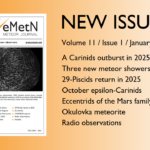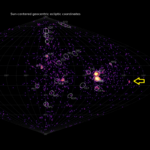Abstract: A summary of the activity of the CAMS BeNeLux network during the month of September 2019 is presented. September 2019 counted many clear nights. 30389 meteors were recorded,14826 of which proved multiple station, or 49%. A total of 4609 orbits were collected during this month.
1 Introduction
In general September tends to be a very favorable month for meteor observations with a rich activity although no major showers are active this month. The only uncertainty remains the weather which has been favorable in recent years during this month. What would September 2019 bring?
2 September 2019 statistics
CAMS BeNeLux collected 30389 meteors of which 14826 or 49% were multi-station, good for 4609 orbits. This is about 20% less than previous year. This month counted as many as 15 nights with more than 100 orbits. The best September night was 20–21 with as many as 456 orbits in a single night. Only one night remained without any orbits. The statistics of September 2019 are compared in Figure 1 and Table 1 with the same month in previous years since the start of CAMS BeNeLux in 2012. In 8 years, 209 September nights allowed to obtain orbits with a grand total of 24013 orbits collected during September during all these years together.
The weather was very favorable and September 2019 allowed to register more than 1000 meteors extra compared to September 2018. However, the return in number of orbits was finally almost 1000 orbits less than what we got during the 2018 record month for September. The northern part of the CAMS BeNeLux network suffered less good coverage as some of the CAMS stations were temporarily inactive or unable to contribute for various reasons. While the first three weeks of September had favorable weather, from September 22 onwards the BeNeLux got rather very poor weather circumstances.
The volume of atmosphere monitored by the CAMS BeNeLux cameras is huge. If all or most cameras are kept operational, most of the meteors registered will help to obtain an orbit. However as soon as several cameras, or some stations drop out for whatever reason, the remaining cameras have less chance to get multi-station results. The difference in number of orbits between 2019 compared to 2018 shows how much the success of a camera network depends on a common effort by the different stations.

Figure 1 – Comparing September 2019 to previous months of September in the CAMS BeNeLux history. The blue bars represent the number of orbits, the red bars the maximum number of cameras running in a single night and the yellow bar the average number of cameras running per night.
Table 1 – September 2019 compared to previous months of September.
| Year | Nights | Orbits | Stations | Max. Cameras | Min. Cameras | Mean Cameras |
| 2012 | 18 | 209 | 5 | 5 | – | 3.4 |
| 2013 | 19 | 712 | 9 | 20 | – | 13.7 |
| 2014 | 27 | 1293 | 14 | 32 | – | 22.0 |
| 2015 | 29 | 2763 | 15 | 46 | – | 30.0 |
| 2016 | 30 | 3982 | 19 | 54 | 32 | 46.5 |
| 2017 | 29 | 4839 | 22 | 83 | 47 | 70.2 |
| 2018 | 28 | 5606 | 20 | 80 | 57 | 65.4 |
| 2019 | 29 | 4609 | 20 | 79 | 64 | 72.3 |
| Total | 209 | 24013 |
3 Conclusion
September 2019 confirmed the reputation of this month with a very rich background meteor activity and favorable weather. The smaller number of orbits compared to September 2018 can be explained by the fact that a few camera stations were not available for different reasons.
Acknowledgment
Many thanks to all participants in the CAMS BeNeLux network for their dedicated efforts. Thanks to Martin Breukers for providing all the data on which this report is based. The CAMS BeNeLux team was operated by the following volunteers during the month of September 2019:
Hans Betlem (Leiden, Netherlands, CAMS 371, 372 and 373), Jean-Marie Biets (Wilderen, Belgium, CAMS 379, 380, 381 and 382), Martin Breukers (Hengelo, Netherlands, CAMS 320, 321, 322, 323, 324, 325, 326 and 327, RMS 328 and 329), Guiseppe Canonaco (Genk, RMS 3815), Bart Dessoy (Zoersel, Belgium, CAMS 397, 398, 804, 805, 806 and 888), Jean-Paul Dumoulin and Christian Walin (Grapfontaine, Belgium, CAMS 814 and 815, RMS 003814), Luc Gobin (Mechelen, Belgium, CAMS 390, 391, 807 and 808), Tioga Gulon (Nancy, France, CAMS 3900 and 3901), Robert Haas (Alphen aan de Rijn, Netherlands, CAMS 3360, 3361, 3362, 3363, 3364, 3365, 3366 and 3367), Robert Haas (Texel, Netherlands, CAMS 810, 811, 812 and 813), Robert Haas / Edwin van Dijk (Burlage, Germany, CAMS 801, 802, 821 and 822), Klaas Jobse (Oostkapelle, Netherlands, CAMS 3030, 3031, 3032, 3033, 3034, 3037, 3038 and 3039), Hervé Lamy (Dourbes, Belgium, CAMS 394 and 395), Hervé Lamy (Humain Belgium, CAMS 816), Hervé Lamy (Ukkel, Belgium, CAMS 393), Koen Miskotte (Ermelo, Netherlands, CAMS 351, 352, 353 and 354), Tim Polfliet (Gent, Belgium, CAMS 396), Steve Rau (Zillebeke, Belgium, CAMS 3850 and 3852), Paul and Adriana Roggemans (Mechelen, Belgium, CAMS 383, 384, 388, 389, 399 and 809, RMS 003830 and 003831), Hans Schremmer (Niederkruechten, Germany, CAMS 803) and Erwin van Ballegoij (Heesch, Netherlands,CAMS 347 and 348).




